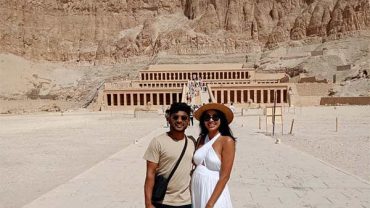Mount Sinai, also called Jabal Mousa, is in the southern part of the Sinai Peninsula in Egypt. It’s a big, impressive mountain that stands out in the dry area around it. It’s about 2,285 meters tall (7,497 feet), and when you’re up there, you can see all the valleys and other mountains. People come here for different reasons, like enjoying nature, learning about history, or finding a quiet place to think. Mount Sinai is not just a regular mountain—it’s special because it means different things to different people.
A Glimpse into History
Mount Sinai, also known as Jabal Mousa, has a captivating history that dates back centuries. It gained prominence through its association with the biblical narrative of Moses receiving the Ten Commandments atop its summit. This event has deeply embedded Mount Sinai in religious and historical contexts. Over time, the mountain has witnessed the passage of various civilizations and cultures, leaving behind traces of their existence.
Ancient inscriptions and ruins on its slopes tell stories of different people who found significance in this sacred place. From the era of Moses to the Byzantine and early Christian periods, Mount Sinai has been a silent witness to the unfolding chapters of human history. Exploring its history allows us to connect with the roots of ancient narratives and appreciate the enduring legacy of this iconic mountain.
Scaling the Heights
Sinai also known as Jabal Mousa, stands tall at an elevation of approximately 2,285 meters (7,497 feet). As one of the prominent peaks in the southern part of the Sinai Peninsula, Egypt, it offers a challenging yet rewarding ascent for those eager to explore its heights. Climbing Mount Sinai involves navigating well-established trails and pathways that wind their way up the rugged slopes.
The journey to the summit unveils breathtaking vistas, making the physical effort worthwhile. Whether undertaken for spiritual reasons, historical curiosity, or simply a love for nature, scaling the heights of Mount Sinai provides a unique perspective of the surrounding landscape, creating lasting memories for those who undertake this memorable ascent.
Sunrise Magic
Spiritual Resonance
Mount Sinai, also called Jabal Mousa, holds a deep spiritual resonance that goes beyond its physical grandeur. For many, this sacred mountain is more than just a geographical landmark—it’s a place where the soul finds solace and connection. The quiet slopes and serene landscapes create an atmosphere of contemplation, inviting seekers and pilgrims to reflect on matters beyond the everyday. The very air seems to carry a sense of reverence as if the mountain itself holds ancient wisdom.
Whether one approaches it from a religious perspective or seeks a moment of personal introspection, Mount Sinai offers a space for spiritual exploration and connection with something greater. It’s a sanctuary of the soul, where the echoes of history and the whispers of nature converge to create a uniquely profound and spiritual experience.
Nature’s Palette
Bedouin Culture
On Mount Sinai, the rich tapestry of Bedouin culture unfolds, adding a cultural dimension to the majestic landscape. The local Bedouin communities, who have called the Sinai region home for generations, contribute a unique and authentic touch to the mountain’s story. Engaging with Bedouin culture on Mount Sinai offers a glimpse into their traditional way of life, marked by hospitality, resilience, and a deep connection to the land. Bedouin guides often share their knowledge of the mountain, its hidden trails, and the stories woven into its rocks.
Encounters with Bedouin nomads along the way provide an opportunity to appreciate their customs, traditional dress, and the warmth with which they welcome visitors. This cultural exchange transforms the journey on Mount Sinai into more than a physical ascent; it becomes a shared experience that bridges the gap between nature and the people who have thrived in its midst for centuries.






Comment (0)